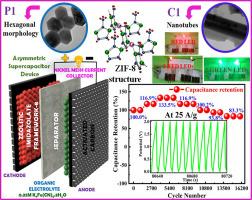High electrochemical performance of solvothermally-assisted ZIF-8 based asymmetric supercapacitor device with synergetic effect of surfactants and electrolytes
IF 5.7
3区 材料科学
Q2 MATERIALS SCIENCE, MULTIDISCIPLINARY
引用次数: 0
Abstract
The present work reported the asymmetric supercapacitor device of surfactant-assisted zeolitic imidazolate framework-8 (ZIF-8) with outstanding performance utilizing various electrolytes. For this, ZIF-8 was synthesized utilizing a solvothermal technique with non-ionic (polyvinylpyrrolidone; P1) and cationic (cetyltrimethylammonium bromide; C1) surfactants. X-ray diffraction and Brunauer-Emmett-Teller revealed the cubic phase and formation of macropores, respectively. Field emission scanning electron microscopy and high-resolution transmission electron microscopy elucidated the morphological impact. The structural information is captured by RAMAN, and Fourier transform infrared analysis. In three-electrode configuration, the C1 sample demonstrated exceptional energy storage performance, achieving a significant specific capacity of 2442.5 C/g (5 A/g). In addition, employing C1 and activated carbon electrodes yielded remarkable performance characteristics, including a specific capacitance of 212.2 F/g, an energy density of 117.9 Wh/kg, and a power density of 16,670.8 W/kg. Moreover, at 25 A/g, the device exhibited excellent coulombic efficiency (100%) and cycling stability (83.3%) over 16,000 charge-discharge cycles.

具有表面活性剂和电解质协同作用的溶剂热辅助ZIF-8基非对称超级电容器器件的高电化学性能
本文报道了表面活性剂辅助沸石咪唑酸框架-8 (ZIF-8)的不对称超级电容器装置,该装置利用多种电解质具有优异的性能。为此,ZIF-8利用溶剂热技术与非离子型(聚乙烯吡咯烷酮,P1)和阳离子型(十六烷基三甲基溴化铵,C1)表面活性剂合成。x射线衍射和brunauer - emmet - teller衍射分别显示了立方相和大孔的形成。场发射扫描电镜和高分辨率透射电镜分析了形态学影响。利用拉曼光谱和傅里叶变换红外分析捕获结构信息。在三电极结构中,C1样品表现出优异的储能性能,实现了2442.5 C/g (5 a /g)的显著比容量。此外,采用C1和活性炭电极获得了显著的性能特征,包括比电容为212.2 F/g,能量密度为117.9 Wh/kg,功率密度为16,670.8 W/kg。此外,在25 A/g下,该器件在16,000次充放电循环中表现出优异的库仑效率(100%)和循环稳定性(83.3%)。
本文章由计算机程序翻译,如有差异,请以英文原文为准。
求助全文
约1分钟内获得全文
求助全文
来源期刊

Materials Research Bulletin
工程技术-材料科学:综合
CiteScore
9.80
自引率
5.60%
发文量
372
审稿时长
42 days
期刊介绍:
Materials Research Bulletin is an international journal reporting high-impact research on processing-structure-property relationships in functional materials and nanomaterials with interesting electronic, magnetic, optical, thermal, mechanical or catalytic properties. Papers purely on thermodynamics or theoretical calculations (e.g., density functional theory) do not fall within the scope of the journal unless they also demonstrate a clear link to physical properties. Topics covered include functional materials (e.g., dielectrics, pyroelectrics, piezoelectrics, ferroelectrics, relaxors, thermoelectrics, etc.); electrochemistry and solid-state ionics (e.g., photovoltaics, batteries, sensors, and fuel cells); nanomaterials, graphene, and nanocomposites; luminescence and photocatalysis; crystal-structure and defect-structure analysis; novel electronics; non-crystalline solids; flexible electronics; protein-material interactions; and polymeric ion-exchange membranes.
 求助内容:
求助内容: 应助结果提醒方式:
应助结果提醒方式:


